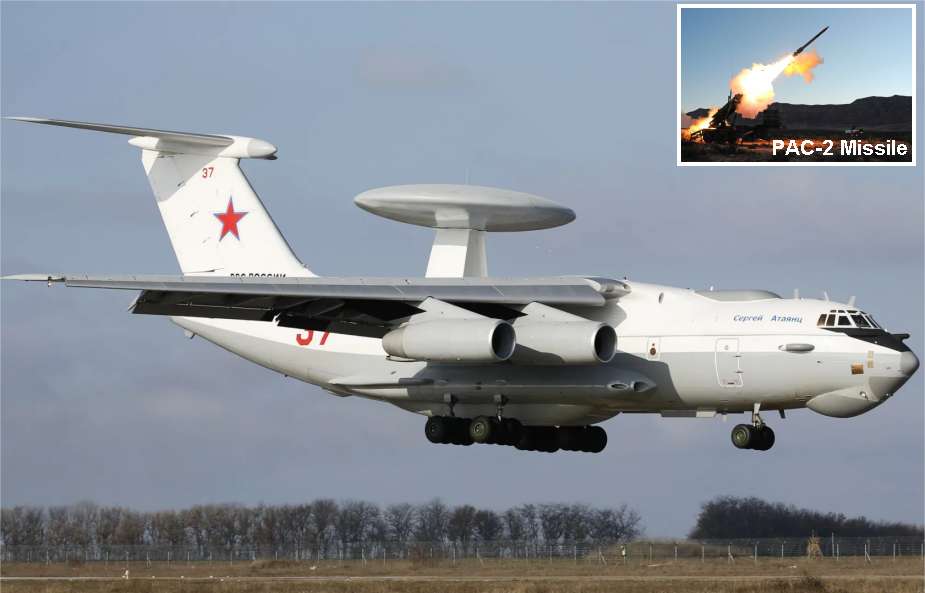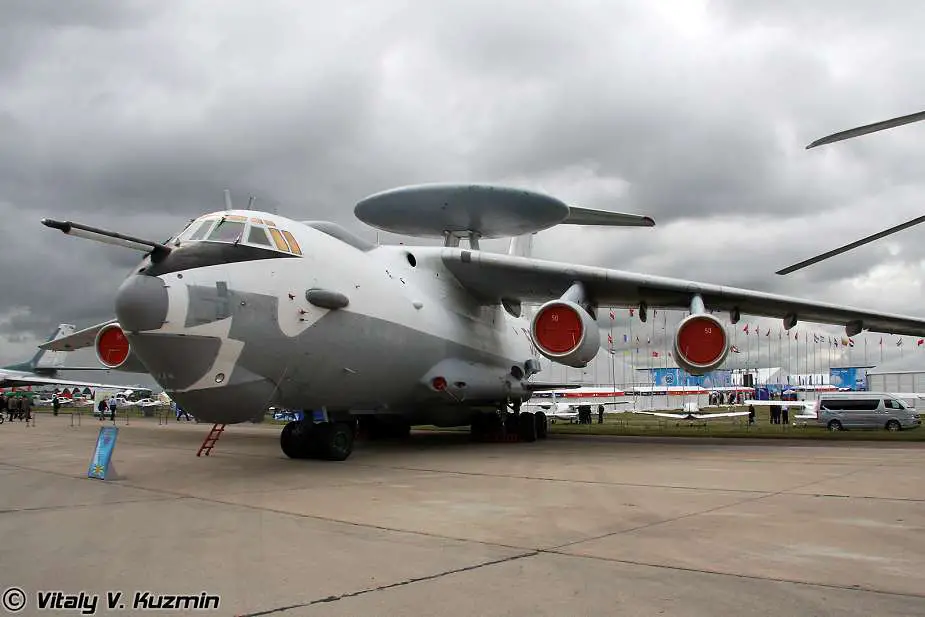Key Russian A-50 Surveillance Aircraft Downed by Suspected Ukrainian Patriot PAC-2 Missile Strike
In a significant development amidst the ongoing conflict in Ukraine, the British Intelligence Services reported on January 14, 2024, that a Russian Beriev A-50 (NATO reporting name: Mainstay) Airborne Early Warning and Control aircraft almost certainly exploded and subsequently crashed into the western Sea of Azov. The incident, marking a critical loss for the Russian Air Force, occurred near Berdiansk, approximately a hundred kilometers from the frontline. Speculation arises that a Patriot PAC-2 battery, with a range of 160 kilometers, might have successfully targeted the Russian А-50 Mainstay aircraft.
Follow Army Recognition on Google News at this link

The Russian A-50 airborne early warning and control aircraft would have been shot down by a Patriot PAC-2 surface-to-air missile fired by the Ukrainian forces. (Picture source Social Network editing Army Recognition)
The PAC-2 Patriot missile system, known for its advanced air and missile defense capabilities, is equipped with a radar and missile technology that provides extensive range and altitude coverage for both detection and engagement of threats. The radar system associated with the PAC-2, the AN/MPQ-53 or AN/MPQ-65, is capable of detecting and tracking targets at a range of up to 160 kilometers (100 miles), offering wide-area surveillance and target acquisition capabilities.
In terms of interception, the PAC-2 missiles have an effective range of approximately 70 kilometers (43 miles) and can reach altitudes of up to 24 kilometers (15 miles). This extensive range and altitude coverage enable the PAC-2 to effectively counter a diverse array of aerial threats, including high-altitude strategic bombers, as well as lower-flying cruise missiles.
Adding to the Russian woes, reports surfaced of a Russian IL-22M COOT B aircraft sustaining damage, though it managed to land at a nearby Russian airfield. In a bold statement dated January 15, 2024, Ukrainian Commander in Chief, General Valery Zaluzhnyi, claimed responsibility for both the downing of the A-50 and the damage inflicted on the COOT B aircraft.
This incident marks a pivotal moment in the conflict, potentially altering the dynamics of air warfare in the region. The loss of the A-50 MAINSTAY, a key asset in Russia's air surveillance and control capabilities, signifies a major setback. This aircraft plays an integral role in monitoring and directing air operations over the battlefield, and its absence could severely impact Russian air operation strategies.
While Russia reportedly has eight A-50 aircraft in its fleet, the destruction of one and the increased operational demands on the remaining fleet pose significant challenges. The loss of skilled crew members in the incident further exacerbates the situation, potentially hindering the sustainability of longer-term missions and operations.
This event could force Russia to reconsider the operational areas of its remaining aircraft, limiting their effectiveness and reach. The vulnerability of these critical assets has been starkly highlighted, and the Ukrainian forces' capability to target such high-value assets marks a notable shift in the balance of air power in the region.

The A-50 MAINSTAY is a linchpin in the Russian Air Force able to detect targets at a range of up to 400 km. (Picture source Vitaly Kuzmin)
The A-50 MAINSTAY, a linchpin in the Russian Air Force, seamlessly integrates the roles of an advanced airborne early warning and control system (AEW&C) and a powerful airborne command center. This aircraft is equipped with the sophisticated "Vega-M" radar, capable of tracking up to 150 targets simultaneously within a 230-kilometer radius and detecting larger targets like surface ships up to 400 kilometers away. Its pivotal role extends beyond mere surveillance; the A-50 MAINSTAY is adept at controlling up to ten fighter aircraft for varied missions, including air-to-air intercepts and air-to-ground attacks. This dual capability as both a surveillance and command platform makes it indispensable in orchestrating complex aerial strategies and maintaining aerial superiority.
In terms of operational capability, the A-50 can sustain up to four hours of flight at a range of 1,000 kilometers from its base, with a maximum takeoff weight of 190 metric tons. Its endurance is further enhanced by the possibility of mid-air refueling, courtesy of Il-78 tankers. The A-50U, its modernized variant, marks a significant technological leap. Initiated in 2003 with state tests beginning in 2008, this version boasts a new digital avionics suite produced by NPO Vega, replacing the older analog system. This upgrade not only streamlines data processing but also sharpens signal tracking and target detection capabilities. Moreover, the A-50U includes improved amenities for crew welfare, such as rest areas, toilets, and a galley, reflecting its critical role in extended and strategic air operations.
Defense News January 2024
- Hits: 2325
















